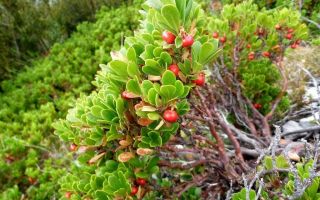Content
- 1 What does bearberry look like and where does it grow?
- 2 The chemical composition of bearberry
- 3 What treats and what helps bear ears grass
- 4 Methods for the preparation and use of bearberry
- 5 The use of the herb of bear ears in traditional medicine
- 6 Application in cosmetology
- 7 Contraindications to the use of bearberry
- 8 When and how to collect common bearberry
- 9 Conclusion
- 10 Reviews of the medicinal properties of bearberry leaves and contraindications
Useful properties of bearberry and contraindications must be studied before using the bear's ear plant. The herb has a beneficial effect on the body, but requires careful use.
What does bearberry look like and where does it grow?
The common bearberry (Arctostaphylos uva-ursi) is a perennial evergreen from the Heather family, which can also be found under the name of the bear's ear. It is a branchy creeping shrub up to 30 cm tall with recumbent stems.
The leaves of the plant are oblong, ovoid, with a leathery surface. At the base, the plates taper to a short petiole, and at the top they are rounded. In May and June, the bearberry blooms with drooping pink-white buds, collected in apical carpal inflorescences. From August to the end of September, it bears fruit with bright red drupes with mealy pulp and five seeds inside.
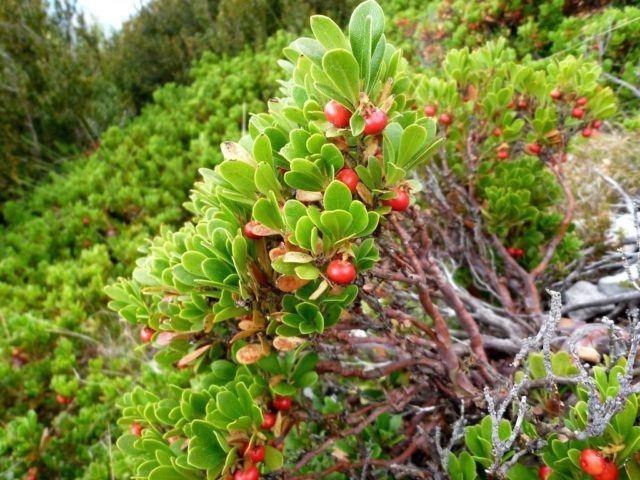
The plant is widespread in the United States, Canada, and northern Eurasia. Prefers deciduous and pine forests, clearings and burnt-out areas, rocky slopes. Selects dry and well-lit areas. It reacts negatively to the neighborhood and the struggle for resources with other plants, therefore, it is almost impossible to meet bearberry in dense thickets and in meadows.
Where does bearberry grow in Russia
In Russia, the plant is widespread in the Far East and Siberia. In the middle lane, it is rare and mainly in non-chernozem regions. Sometimes you can see a bear's ear in the Caucasus.
The chemical composition of bearberry
The benefits and harms of bearberry are due to the chemical composition of the plant. The leaves and stems of the bear's ear contain:
- flavonoids and phytoncides;
- antioxidants;
- gallic acid;
- arbutin;
- vitamin C;
- tannins;
- ursolic acid;
- hydroquinone;
- quercetin and isoquercetin;
- methylarbutin;
- quinic and malic acids;
- myricitrin and myricetin.
Bear ears must be used with care so that the active substances do not harm the body. But when used by prescription, the herb can help treat a wide variety of conditions.
What heals and what helps bear ears grass
Alcohol and water products based on a useful plant strengthen the body.You can use bear ears for respiratory and colds, with disorders of digestion and metabolism, with bacterial processes. In particular, bearberry:
- fights infections and relieves inflammation in the urinary tract;
- strengthens blood vessels and prevents the development of heart ailments;
- lowers blood sugar;
- improves the condition with bronchitis, pneumonia and tuberculosis;
- relieves pain and restores mobility in case of rheumatism, gout and arthritis;
- removes toxins and toxic substances from the body, improves liver function;
- has a diuretic effect and helps with cystitis and urethritis;
- stops bleeding;
- disinfects cuts and wounds when applied externally;
- eliminates heartburn and improves well-being with gastritis.
You can use the medicinal properties of the bearberry ordinary for skin care - the plant has a rejuvenating and tonic effect.
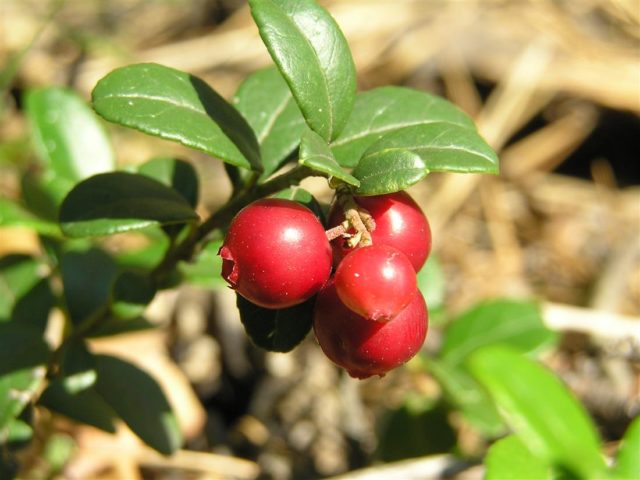
What bearberry leaves help from
Traditional medicine uses the leaves of the plant most actively. They contain gallic and ursular acids, as well as tannins. Infusions and decoctions of leaves help with diarrhea and intestinal inflammation, with bacterial processes in the genitourinary and respiratory system. The funds can be used both internally and externally - to treat damage and irritation on the skin.
Useful properties of bearberry
The berries of the plant are also in demand in health recipes. They contain a lot of ascorbic acid, have healing and antipyretic properties.
Bearberry fruits are used for delayed digestion, enteritis and cholecystitis, for jaundice and hepatitis. Decoctions and infusions of berries are beneficial for eye diseases, help stop bleeding.
Useful properties of bearberry for women
The anti-inflammatory properties of bear ears make them especially valuable in the treatment of female reproductive diseases. The plant is often used for cystitis, it normalizes the work of the excretory system, eliminates pain and discomfort. It is possible to use herbal infusions and decoctions for venereal infections and uterine bleeding.
Useful properties of bearberry for men
Bear ears are recommended for men with prostatitis. Tinctures and decoctions based on the plant relieve inflammation and pain, eliminate the bacterial process and facilitate urination.
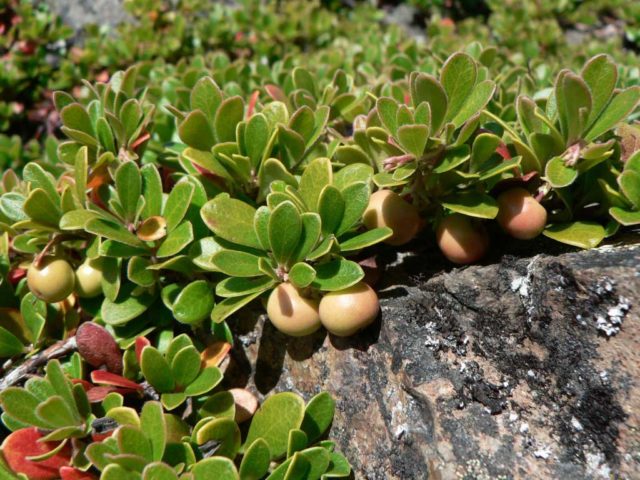
The benefits of bearberry for children
The bear ears plant has a beneficial effect on children's immunity and improves the condition in case of intestinal disorders. Kissel based on bearberry berries is prescribed for gastritis and diarrhea. The remedy relieves pain and normalizes digestion.
However, only adolescents 12 years of age and older are allowed to offer bear ears medications. Many substances in the composition of the fruits and leaves of the plant are toxic and can harm the baby's body.
Useful properties of bearberry for cystitis
Bearberry heals especially well for cystitis; it is very popular among women. Decoctions and infusions of the plant eliminate the bacterial process and relieve inflammation, quickly remove pain and spasms, and normalize urination.
Since bearberry is a natural diuretic, it removes excess fluid from the body and cleanses the bladder of accumulated harmful substances and toxins. The use of bear ears in the complex treatment of cystitis helps to quickly eliminate unpleasant symptoms and restore good health.
Methods for the preparation and use of bearberry
Healing herb is used for the preparation of alcohol and water products.Traditional medicine recipes are quite simple and allow you to make effective medicines at home.
Bearberry tincture
Bearberry is useful for rheumatism, gout and cancer pain. An alcohol tincture brings a good effect, and the remedy is prepared as follows:
- 40 g of dry leaves of a bear's ear are poured into a glass vessel;
- pour raw materials 250 ml of high-quality vodka;
- insist the solution in a dark place for two weeks.
The filtered agent is taken 15 drops three times a day on a full stomach.
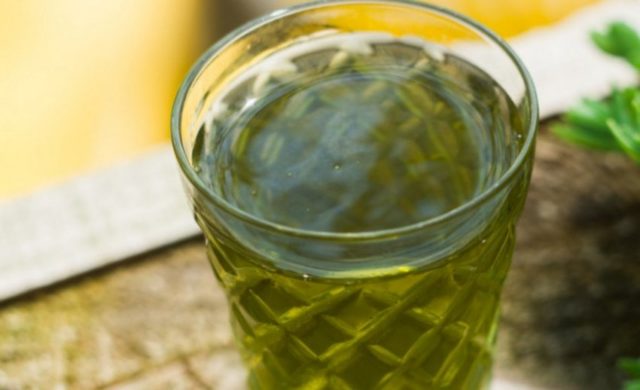
Infusion of bearberry leaves
An aqueous infusion can be prepared from the leaves of the plant; it will be beneficial for diarrhea and intestinal inflammation. The recipe looks like this:
- a large spoonful of dry leaves is poured with a glass of hot water;
- cover the container with a lid and leave for an hour;
- passed through cheesecloth.
Bearberry has an expectorant effect, therefore, using an infusion on its leaves is useful for bronchitis. You need to drink the product in the same way as regular tea.
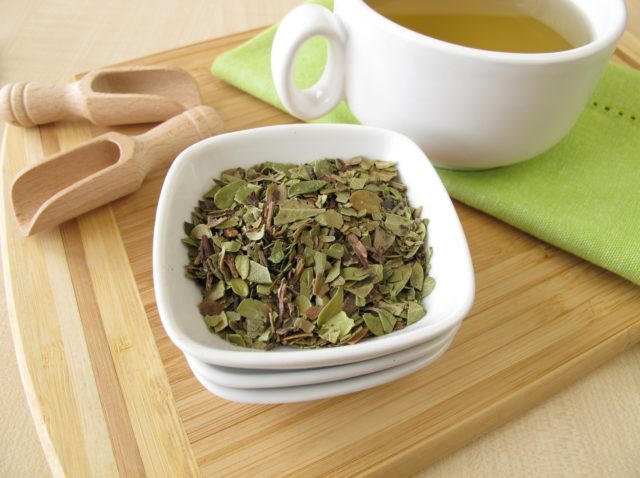
Recipes for making a decoction of bearberry leaves
For gastric diseases, bleeding and edema, traditional medicine suggests using a decoction of bear ears. One of the popular recipes looks like this:
- dry foliage is ground into powder with a mortar;
- measure out a large spoonful of raw materials and pour a glass of boiling water;
- place the mixture in a water bath and heat for 15 minutes;
- removed from heat and kept under the lid for another half hour.
The filtered agent is topped up with clean liquid to the initial volume and 50 ml is drunk three times a day. You need to take the broth after meals so that the tannins in the drink do not irritate the stomach mucous membranes.
The use of Bear Ears Kidney Herb is based on a different recipe:
- 10 g of dry bearberry leaves are measured;
- pour 500 ml of cold water;
- leave at room temperature under a lid for 12 hours;
- after the expiration of the period, warm up over low heat for ten minutes and filter.
They drink 30 ml of the product three times a day, also on a full stomach.

The use of the herb of bear ears in traditional medicine
Bear ears are found in many home health recipes. They are used both in pure form and in combination with other useful plants.
How to take bearberry for cystitis in women
To eliminate inflammation with cystitis, use an infusion on the leaves of bear ears. The recipe looks like this:
- two large spoons of dry bearberry pour 500 ml of hot water;
- remove the solution for a day in a dark place;
- filter after time.
It is necessary to use the infusion after meals, 50 ml three times a day. The course of treatment with bearberry continues for ten days, the drink is taken warm.
With hemorrhoids
The healing properties of bearberry help with inflammation of hemorrhoids, promote healing and stop bleeding. Traditional medicine recommends using a decoction of the plant. They do it like this:
- 30 g of dry bearberry leaves are steamed with 800 ml of boiling water;
- in a water bath, the solution is heated for 15 minutes;
- the product is filtered and poured into a sitz bath.
The liquid temperature should be no more than 37 ° C. The lower body should be immersed in the bath for five minutes. The procedures should be repeated every evening until the condition improves.
With nervous disorders
Bearberry leaves have a good effect on increased anxiety and insomnia, especially when combined with other plants. The recipe for a healing collection looks like this:
- 30 g of dry bearberry is mixed with an equal amount of motherwort herb;
- measure out two large spoons of raw materials and pour 750 ml of liquid;
- boil the product in a water bath until the total volume decreases by a third;
- cool the broth and filter.
The ready-made collection is taken in 50 ml on an empty stomach up to three times a day.
With gout
Among the indications for the use of bearberry leaves is gout, accompanied by pain and swelling of the joints. Traditional medicine recommends this decoction:
- three large tablespoons of bearberry leaves steamed with 500 ml of hot liquid;
- simmer the mixture over low heat for 15 minutes;
- removed from the stove and covered with a lid until it cools.
The strained broth is taken in 50 ml with meals twice a day.
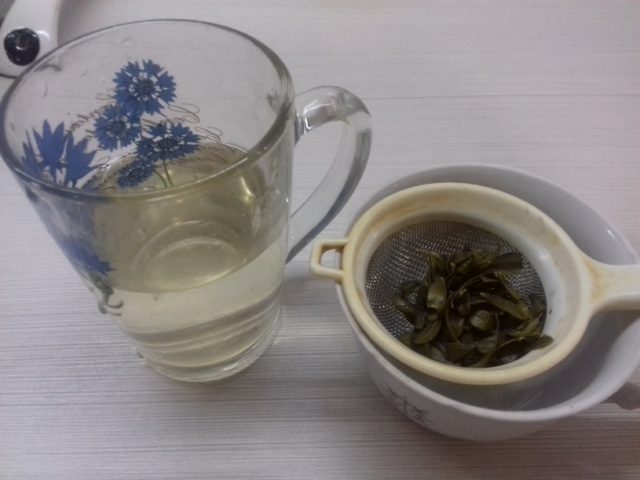
With tuberculosis
Bearberry copes well with bacterial processes and relieves tuberculosis. For treatment, such a remedy is prepared:
- two large spoons of dried leaf plates pour 100 ml of vodka;
- clog the vessel and put it in a dark cabinet for two weeks;
- from time to time, the tincture is removed and shaken.
The finished product is filtered from the sediment and taken ten drops three times a day after meals.
For intestinal disorders
Bearberry is used to relieve abdominal pain and diarrhea. Such a remedy has a good effect:
- a small spoonful of bear grass is poured with 150 ml of water;
- add 250 ml of milk;
- bring the mixture to a boil and insist under the lid for another hour.
You need to take the drink in several sips throughout the day until you feel better.
Application in cosmetology
The medicinal properties of the plant bear ears are used for skin and hair care. Infusions and decoctions of bearberry leaves brighten the epidermis, make age spots and freckles less noticeable, rejuvenate and refresh the face.
To improve skin color, you can use the following remedy:
- 25 g of a dry plant is poured into 300 ml of liquid;
- warm up in a water bath for ten minutes;
- filter and cool until warm.
In the finished infusion, moisten a cotton pad and wipe the face 6-7 times a day. Additionally, the remedy will help get rid of acne and inflammation.
Contraindications to the use of bearberry
Instructions for the use of the herb bear ears notes that the plant has contraindications. You cannot use decoctions and infusions:
- with renal failure;
- with glomerulonephritis;
- with individual allergies.
You should not drink products based on bear ears during pregnancy, as the herb can provoke a miscarriage. Contraindications include the lactation period - bearberry is highly likely to harm the baby.
What is dangerous and side effects of bearberry
When consumed by prescription, the plant is rarely harmful. But if you exceed the recommended dosages, bearberry side effects may develop - vomiting, nausea, diarrhea and fever.
With long-term treatment, bear ears can irritate the renal tubules - this often leads to an exacerbation of inflammatory processes. To reduce the likelihood of negative effects, bearberry should be used in conjunction with plants that have soothing and healing properties. In addition, for the duration of therapy, protein foods and preparations containing alkaloids and alkalis should be excluded from the diet.
When and how to collect common bearberry
For medicinal purposes, bear ears are harvested in April, before entering the decorative period, or in autumn, after the berries have finally ripened. Videos of harvesting bearberry leaves and shoots note that it is necessary to cut off only 3 cm of branches together with the plates. It is not recommended to dig up the whole plant.
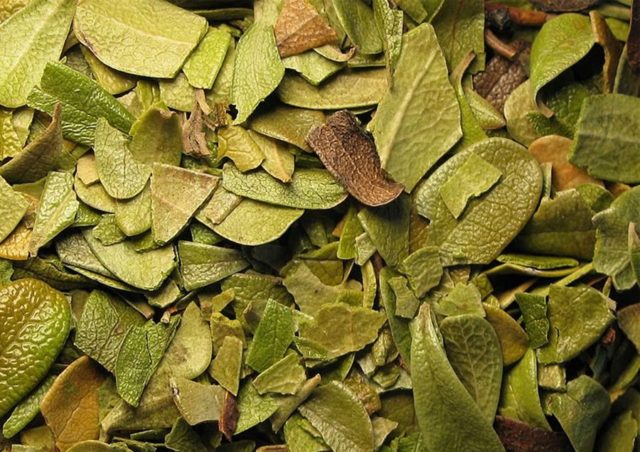
Drying and harvesting of bearberry is carried out outdoors under a canopy in warm weather or indoors with good ventilation. If you wish, you can use the kitchen oven - heat it up to a maximum of 55 ° C. The leaves are separated from the shoots after the raw material dries up.
Bear ears are stored in sealed glass jars or cloth bags. You need to keep the workpieces in a dark place with a low level of humidity.
Conclusion
The beneficial properties of bearberry and contraindications are highly valued by traditional medicine. Most often, the plant is used for inflammation of the urogenital area, but it can also be used for respiratory and digestive ailments.
Reviews of the medicinal properties of bearberry leaves and contraindications

